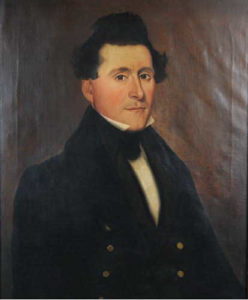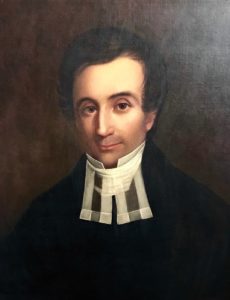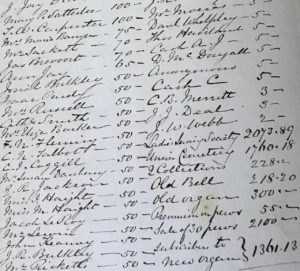By Jeff De Toro
Mary Ann Russell Mount Jewett was a whaling captain’s daughter and a packet ship master’s wife who lived in Rye for many years during the 19th century. From 1852 to 1856, she kept a diary that documented various happenings in her family’s life and the lives of those she knew in the surrounding area, people whose names like Purdy, Halsted, Loder and Jay are found on Rye street signs today. The Jay Heritage Center recently came into possession of her diary and has discovered that it provides a unique snapshot of Rye in the mid-1850s. Season to season, it reveals how residents got and shared local news and news abroad, performed household chores, prepared foods, called on neighbors or shared carriages to town. It also affords us a glimpse into the central role of religion and the church in society and the tension between classes. Ensuing installments of this blog will go into greater depth about these topics based on actual entries in the handwritten journal.
About the Diarist
Mary Ann, the author of the diary, was the child of American parents but she was born abroad, likely in London. Records describe her as “a very beautiful Englishwoman”[1] and “a fine daughter”[2]. Originally from Nantucket, her father, Captain Laban Russell, eventually purchased a 24-acre parcel of land between Rye and Port Chester (near the current site of the Rye Country Day School) in 1825 and settled into an existing home (believed to have been built by prominent jeweler Frederick Marquand) on that property. Both Laban and his wife Mary Hayden were descendants of many generations of mariners and so too one of Mary Ann’s brothers (William Hayden Russell) and her own son (Laban Russell Jewett) would pursue seafaring professions.

We do not know what led Mary Ann’s parents to relocate from Nantucket to Rye but the nearby town of Saw Pit (renamed Port Chester in 1837) was a hub of shipbuilding (specifically masts and rigging) as far back as the early 1700s. More importantly it was a convenient stop for steamers and sloops to other ports like New York, New Haven and Stamford. Perhaps Captain Russell had decided to forsake the unpredictable and dangerous pursuit of whales for simpler and more regular ocean passages. He had completed several arduous voyages, survived a mutiny and completed a trip from London to Australia and Asia in charge of the whaling ship Emily. He was accompanied on this journey by his wife and sons William (who served as boatsteerer) and Charles (who was a child at the time).[3]
Mary Ann however was not on the ship with them having already married at the age of 16 a certain Captain Forman Marshall Mount. Her betrothed, Capt. Mount regularly transported cargo of barrel staves and passengers between the US and UK and apparently transported his bride back to America as well. Their time together was brief as Mount died when he was only 34; he was buried at Greenwood Union Cemetery. As a widow with two girls (Caroline and Mary), it is not surprising that Mary Ann remarried.
Mary Ann’s second husband was Eleazer Jewett, a nail maker out of Norwich, Connecticut and they had four sons (Washington, Marshall, Laban, and William). As of 1839, following the untimely death of Eleazer, she moved with her children back to her parents’ home in Rye. She lived there through her father’s death in 1842, her mother’s illness and passing in 1855, and finally a nasty property battle between her siblings that resulted in Mary Ann’s exodus from Rye which is thoroughly detailed in the diary.

The Russell Family and Christ’s Church Community
The Russells became active in the community and in the local Episcopal house of worship, Christ’s Church. Historic records show that the Russells were “communicants” (the Episcopal term for parishioners) and donors at Christ’s Church from the 1830s through the 1850s, at the same time that Peter Augustus Jay and Dr. John Clarkson Jay served on the vestry (governing board) at the church.
As a widow, known as Mrs. Jewett, Mary Ann had a social life that revolved around the church from helping to decorate with greens at Christmas to providing music at services. On January 1, 1853 she recorded that she had received a note from Dr. Jay “enclosing $20, which was due me from the Vestry of Rye Church, on the 1st of last Aug., for Morn Services.” A later entry dated March 14, 1853 provided clarification on Mrs. Jewett’s role at the church as she wrote “I signified to Mr. S [James Stebbins, another vestry member] that it was my intention to resign the charge of the Organ and requested him to mention it to the Vestry.” Evidently a reliable replacement was not easy to come by; she noted with some exasperation on Sunday, June 8, 1853 “Mr. Bull has requested I would play the Organ as Miss Allaire has a sore finger.” On Sunday, June 22, 1853, she explained, “By Mr. Bull’s request, I played the Organ. Miss Allaire absent in consequence of a death in the family.”

The Russells and Jays were more than just fellow communicants at Christ’s Church. Mary Jewett was “1st Directress” of a Ladies Sewing Society that included Laura Prime Jay (Dr. Jay’s wife) as a “Manager” and, according to the diary, they occasionally met at the Jay Mansion between 1853-1855. That same group of women, through hours of industrious needlework, contributed $2073.89 towards monies to build a new church after the old one burned down. On Wednesday, May 31 Mary confirms, “The cornerstone of our new church laid by our Rector E. C. Bull, the Bishop not able to attend.”
This valuable eyewitness record allows us to now imagine (among the many other activities that occurred there) a circle of ladies sewing slippers and “melon seed bag(s)” while discussing the events of the day in the Jay Family Drawing Room – from weddings and funerals to the travails of friends or loved ones at sea. Mary’s diary entries have thus helped further our interpretation of the Jay Mansion as a social hub for the Rye community.
[1] “Historical and Genealogical Miscellany: Data Relating to the Settlement and Settlers of New York and New Jersey”, John E. Still Well, MD, Vol. IV, New York, 1916
[2] Transcript of interview with Edward Mitchell (of Nantucket, MA), private papers of Mary E. Starbuck, Nantucket Historical Society.
[3] Letter-Journal of Mary Hayden Russell, Nantucket Historical Society.
